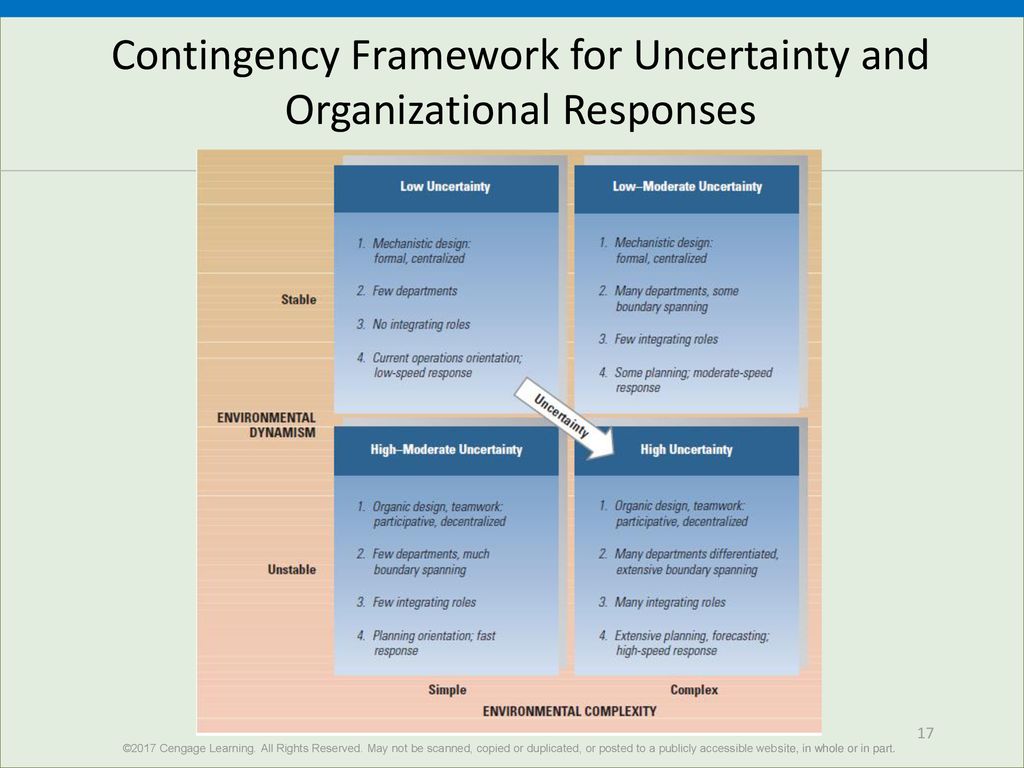Planning and Forecasting
Environmental Planning, Forecasting, and Responsiveness
The whole point of increasing internal integration and shifting to a more organic designOpens in new window is to enhance the organization’s ability to quickly respond to sudden changes in an uncertain environmentOpens in new window.
It might seem that in an environment where everything is changing all the time, planning is useless. However, in uncertain environmentsOpens in new window, planning and environmental forecasting actually become more important as a way to keep the organization geared for a coordinated, speedy response.
When the environment is stable, the organization can concentrate on current operational problems and day-to-day efficiency. Long-range planning and forecasting are not needed because environmental demands in the future will be much the same as they are today.
With increasing environmental uncertaintyOpens in new window, planning and forecasting become necessary.
Indeed, surveys of multinational corporations have found that as environments become more turbulent, managers increase their planning activities, particularly in terms of planning exercises that encourage learning, continual adaptation, and innovation.
For example, following the September 11, 2001, terrorist attacks in the United States, there was a surge in the use of scenario and contingency planning as a way to manage uncertainty.
With scenario planningOpens in new window, managers mentally rehearse different scenarios based on anticipating various future changes that could affect the organization.
Scenarios are like stories that offer alternative, vivid pictures of what the future will look like and how managers will respond.
Royal Dutch/Shell OilOpens in new window has long used scenario building and has been a leader in speedy response to massive changes that other organizations failed to perceive until it was too late. Planning can soften the adverse impact of external shifts.
Organizations that have unstable environments often establish a separate planning department. In an unpredictable environment, planners scan environmental elements and analyze potential moves and countermoves by other organizations.
Planning, however, cannot substitute for other actions, such as effective boundary spanningOpens in new window and adequate internal integrationOpens in new window and coordinationOpens in new window.
The organizations that are most successful in uncertain environments are those that keep everyone in close touch with the environment so they can spot threats and opportunities, enabling the organization to respond immediately.
Framework for Adapting to Complexity and Dynamism
Figure X-7 summarizes the ways in which environmental uncertainty influences organizational characteristics. The complexity and dynamism dimensions are combined and illustrate four levels of uncertainty.
The low uncertainty environment is simple and stable. Organizations in this environment can have few departments and a mechanistic design.
 Figure X-7 Contingency Framework for Uncertainty and Organizational Responses | Credit — Slideplayer Opens in new window
Figure X-7 Contingency Framework for Uncertainty and Organizational Responses | Credit — Slideplayer Opens in new window
|
In a low-moderate uncertainty environment, more departments are needed, along with more integrating roles to coordinate the departments. Some planning may occur.
Environments that are high-moderate uncertainty are simple but unstable. Organization design is organic and decentralized. Planning is emphasized, and managers are quick to make internal changes as needed.
The high uncertainty environment is both complex and unstable and is the most difficult environment from a management perspective. Organizations are large and have may departments, but they are also organic.
A large number of management personnel are assigned to coordination and integration, and the organization uses boundary spanning, planning, and forecasting to enable a high-speed response to environmental changes.
| Remember This! |
|---|
|
The series:
- Organizational EnvironmentOpens in new window
- Environmental UncertaintyOpens in new window
- Adapting to Complexity and DynamismOpens in new window
- Differentiation and IntegrationOpens in new window
- Planning, Forecasting, and ResponsivenessOpens in new window
- Abundance/Scarcity of Needed Financial ResourcesOpens in new window
- Research data for this work have been adapted from the manual:
- Organization Theory & Design By Richard L. Daft

